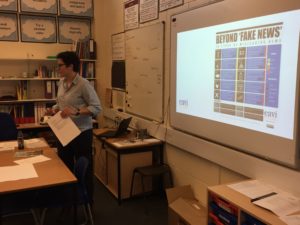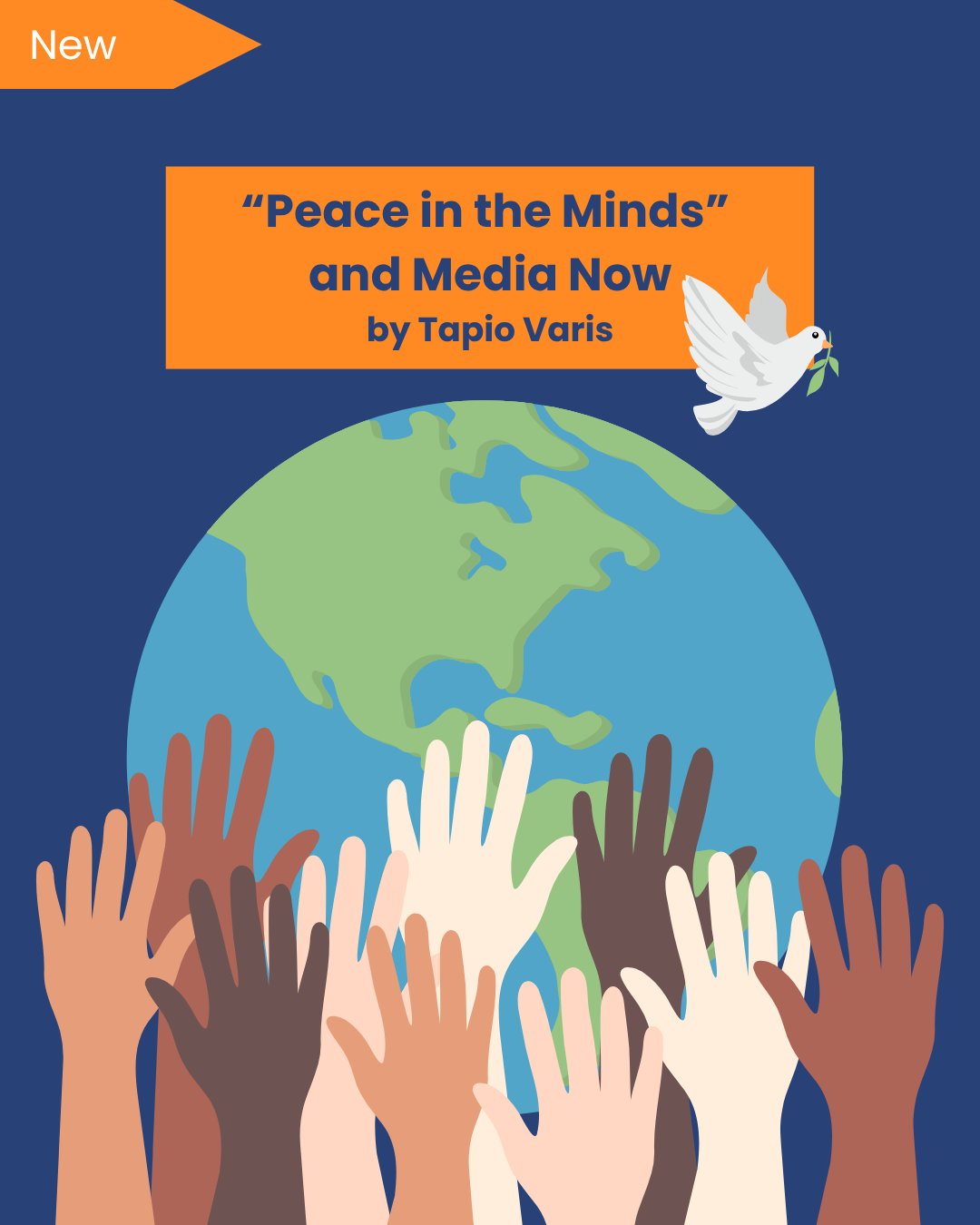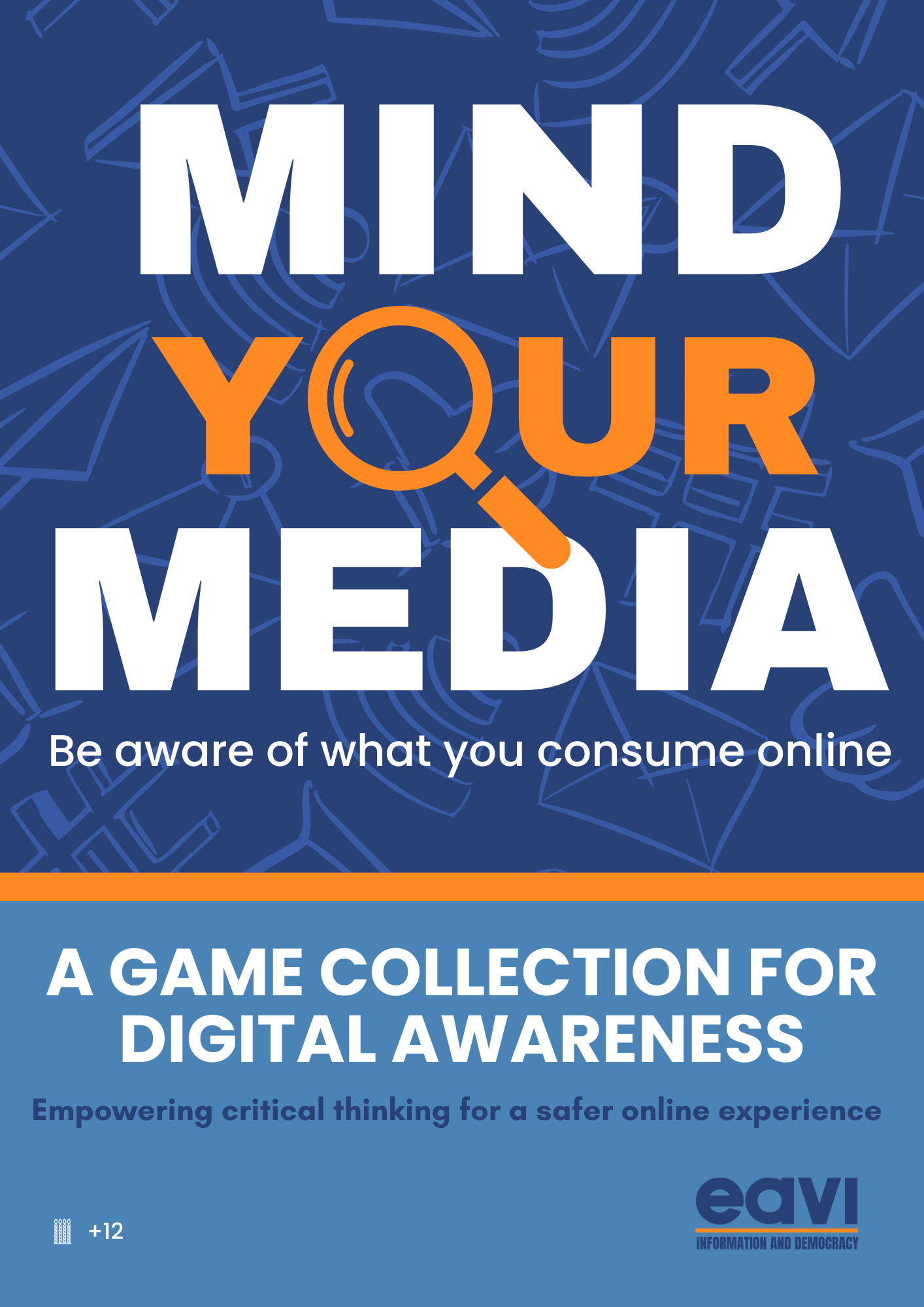
EAVI visited Stokeinteignhead School in Devon, UK, on 16 November 2017 to deliver a workshop introducing 10 and 11 year olds to media literacy.
Naomi Thompson led the seminar, beginning with a discussion about what the media was, its various forms and purposes. Most of the pupils had already used some form of media that day, including television, games, radio and social media. The group were very keen on discussing the pros and cons of each kind of media.
Using visual examples, Naomi explained that the media only ever offers a snapshot of events, it rarely offers a complete understanding, and can be misleading. With this in mind, the groups were given cropped images and asked to draw what they thought was in the rest of the picture. The full images were then revealed. Most of the groups correctly guessed the rest of the picture.
The group then discussed social media. Most of the class were on social media in some way, shape or form, including Instagram, Snapchat, online gaming and YouTube. There was an interesting discussion about what was good and bad about social media, and how it could best be used.
Using examples from her own facebook account, Naomi showed how social media allows individuals to present themselves as a brand. The group were then asked to come up with their own image or status update which said something about themselves without being explicit. A perfect example of this was from a boy who wrote “Check out this cool frame I made”, and in the frame was a perfect test score.
Naomi then led a discussion about privacy on social media. Using their own social media images and updates, she explained what a stranger could glean about their private lives, their activities, etc. Such as “going to Florida – so excited”, meant a burglar would know their house was empty for a week, or the test result scores which would show where they went to school.
The group then discussed ways they could stay safe online, such as keeping their passwords secret, ensuring their privacy settings were up to date, not sharing personal information, and talking to their parents and trusted adults about their online activities, and especially when something online made them sad, uncomfortable or upset.
The group then looked at cyberbullying – discussing how it was different from offline bullying, and what they could do if they or their friends were being bullied. Naomi explained that one of the greatest dangers of cyberbullying was its permanence – the evidence can remain online forever, for both the bullied and the bully, disrupting both their futures. However, because cyberbullying is relatively easily evidenced, victims have much greater recourse. The first piece of advice was, as always, to talk to parents and trusted adults if they or their friends were being bullied or were bullying.
The group had great fun looking at how images in the media are misleading. Starting with spotting photoshopped adverts, which the group were quick to pick up, they looked at how reality is skewed in order to sell us products or convince us to a certain way of thinking, including making models thinner and lightening and darkening skin according to the motivation. The group then came up with their own adverts, acting them out, coming up with their own taglines and thinking about how to make a product attractive to potential buyers.
The final part of the day focused on their rights as citizens, including their right to an education and their right to free speech, the obligations which balance this, such as their obligation to try hard at school, and their obligation to be responsible in what they say. The group agreed, by show of hands, that they would like an input into the school’s fruit-only snack policy.
The group were passionate and excited about this issue, and set out to change it using democratic means, including getting a petition together from pupils, entering into discussion with policy makers (Headteacher and School Governors), launching an information campaign in the form of leaflets and posters, and figuring out ways to negotiate and find solutions to objections. The school have agreed to support this, and Naomi was asked to come in to mentor the children in their efforts.
The day was a success, leaving the participants energised and better aware of some aspects of the media landscape they are entering. They also have a greater understanding of safe social media behaviours, the importance of privacy, and how to respond to cyberbullying. They are now a little less likely to be fooled by misleading advertising and news. And they are better aware of their rights as citizens of the UK and Europe, how they can best exercise those rights, and enter into the democratic process safely and responsibly.

EAVI visited Stokeinteignhead School in Devon, UK, on 16 November 2017 to deliver a workshop introducing 10 and 11 year olds to media literacy.
Naomi Thompson led the seminar, beginning with a discussion about what the media was, its various forms and purposes. Most of the pupils had already used some form of media that day, including television, games, radio and social media. The group were very keen on discussing the pros and cons of each kind of media.
Using visual examples, Naomi explained that the media only ever offers a snapshot of events, it rarely offers a complete understanding, and can be misleading. With this in mind, the groups were given cropped images and asked to draw what they thought was in the rest of the picture. The full images were then revealed. Most of the groups correctly guessed the rest of the picture.
The group then discussed social media. Most of the class were on social media in some way, shape or form, including Instagram, Snapchat, online gaming and YouTube. There was an interesting discussion about what was good and bad about social media, and how it could best be used.
Using examples from her own facebook account, Naomi showed how social media allows individuals to present themselves as a brand. The group were then asked to come up with their own image or status update which said something about themselves without being explicit. A perfect example of this was from a boy who wrote “Check out this cool frame I made”, and in the frame was a perfect test score.
Naomi then led a discussion about privacy on social media. Using their own social media images and updates, she explained what a stranger could glean about their private lives, their activities, etc. Such as “going to Florida – so excited”, meant a burglar would know their house was empty for a week, or the test result scores which would show where they went to school.
The group then discussed ways they could stay safe online, such as keeping their passwords secret, ensuring their privacy settings were up to date, not sharing personal information, and talking to their parents and trusted adults about their online activities, and especially when something online made them sad, uncomfortable or upset.
The group then looked at cyberbullying – discussing how it was different from offline bullying, and what they could do if they or their friends were being bullied. Naomi explained that one of the greatest dangers of cyberbullying was its permanence – the evidence can remain online forever, for both the bullied and the bully, disrupting both their futures. However, because cyberbullying is relatively easily evidenced, victims have much greater recourse. The first piece of advice was, as always, to talk to parents and trusted adults if they or their friends were being bullied or were bullying.
The group had great fun looking at how images in the media are misleading. Starting with spotting photoshopped adverts, which the group were quick to pick up, they looked at how reality is skewed in order to sell us products or convince us to a certain way of thinking, including making models thinner and lightening and darkening skin according to the motivation. The group then came up with their own adverts, acting them out, coming up with their own taglines and thinking about how to make a product attractive to potential buyers.
The final part of the day focused on their rights as citizens, including their right to an education and their right to free speech, the obligations which balance this, such as their obligation to try hard at school, and their obligation to be responsible in what they say. The group agreed, by show of hands, that they would like an input into the school’s fruit-only snack policy.
The group were passionate and excited about this issue, and set out to change it using democratic means, including getting a petition together from pupils, entering into discussion with policy makers (Headteacher and School Governors), launching an information campaign in the form of leaflets and posters, and figuring out ways to negotiate and find solutions to objections. The school have agreed to support this, and Naomi was asked to come in to mentor the children in their efforts.
The day was a success, leaving the participants energised and better aware of some aspects of the media landscape they are entering. They also have a greater understanding of safe social media behaviours, the importance of privacy, and how to respond to cyberbullying. They are now a little less likely to be fooled by misleading advertising and news. And they are better aware of their rights as citizens of the UK and Europe, how they can best exercise those rights, and enter into the democratic process safely and responsibly.

EAVI visited Stokeinteignhead School in Devon, UK, on 16 November 2017 to deliver a workshop introducing 10 and 11 year olds to media literacy.
Naomi Thompson led the seminar, beginning with a discussion about what the media was, its various forms and purposes. Most of the pupils had already used some form of media that day, including television, games, radio and social media. The group were very keen on discussing the pros and cons of each kind of media.
Using visual examples, Naomi explained that the media only ever offers a snapshot of events, it rarely offers a complete understanding, and can be misleading. With this in mind, the groups were given cropped images and asked to draw what they thought was in the rest of the picture. The full images were then revealed. Most of the groups correctly guessed the rest of the picture.
The group then discussed social media. Most of the class were on social media in some way, shape or form, including Instagram, Snapchat, online gaming and YouTube. There was an interesting discussion about what was good and bad about social media, and how it could best be used.
Using examples from her own facebook account, Naomi showed how social media allows individuals to present themselves as a brand. The group were then asked to come up with their own image or status update which said something about themselves without being explicit. A perfect example of this was from a boy who wrote “Check out this cool frame I made”, and in the frame was a perfect test score.
Naomi then led a discussion about privacy on social media. Using their own social media images and updates, she explained what a stranger could glean about their private lives, their activities, etc. Such as “going to Florida – so excited”, meant a burglar would know their house was empty for a week, or the test result scores which would show where they went to school.
The group then discussed ways they could stay safe online, such as keeping their passwords secret, ensuring their privacy settings were up to date, not sharing personal information, and talking to their parents and trusted adults about their online activities, and especially when something online made them sad, uncomfortable or upset.
The group then looked at cyberbullying – discussing how it was different from offline bullying, and what they could do if they or their friends were being bullied. Naomi explained that one of the greatest dangers of cyberbullying was its permanence – the evidence can remain online forever, for both the bullied and the bully, disrupting both their futures. However, because cyberbullying is relatively easily evidenced, victims have much greater recourse. The first piece of advice was, as always, to talk to parents and trusted adults if they or their friends were being bullied or were bullying.
The group had great fun looking at how images in the media are misleading. Starting with spotting photoshopped adverts, which the group were quick to pick up, they looked at how reality is skewed in order to sell us products or convince us to a certain way of thinking, including making models thinner and lightening and darkening skin according to the motivation. The group then came up with their own adverts, acting them out, coming up with their own taglines and thinking about how to make a product attractive to potential buyers.
The final part of the day focused on their rights as citizens, including their right to an education and their right to free speech, the obligations which balance this, such as their obligation to try hard at school, and their obligation to be responsible in what they say. The group agreed, by show of hands, that they would like an input into the school’s fruit-only snack policy.
The group were passionate and excited about this issue, and set out to change it using democratic means, including getting a petition together from pupils, entering into discussion with policy makers (Headteacher and School Governors), launching an information campaign in the form of leaflets and posters, and figuring out ways to negotiate and find solutions to objections. The school have agreed to support this, and Naomi was asked to come in to mentor the children in their efforts.
The day was a success, leaving the participants energised and better aware of some aspects of the media landscape they are entering. They also have a greater understanding of safe social media behaviours, the importance of privacy, and how to respond to cyberbullying. They are now a little less likely to be fooled by misleading advertising and news. And they are better aware of their rights as citizens of the UK and Europe, how they can best exercise those rights, and enter into the democratic process safely and responsibly.








































































































































































